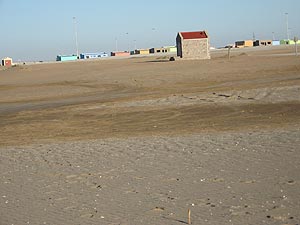|
On the ground in Namibia: Pilot activities of the BCLME programme |
BCLME Programme’s Marine Litter Project
The Marine Litter Project, under the BCLME Programme, aims to assess the current frameworks to deal with the problem of marine litter in Angola, Namibia and South Africa, and to raise awareness on the importance of the issue. The project components are:
- Assess the regulatory/policy framework of the three countries on marine litter
- Review existing marine litter programmes in Angola, Namibia and South Africa
- Carry out marine litter surveys involving schools in pilot areas
- Raise awareness of marine litter through posters/leaflets for schools
Find out more on www.bclme.org or contact Maria Sardinha at the BCLME Programme Activity Centre in Luanda (bclme.behp@nexus.ao). |
 Marine litter survey in Walvis Bay Marine litter survey in Walvis Bay
In the last week of May 2006, the Project Team and a group of students and teachers from the Kuisebmond High School in Walvis Bay, members of the Coastal Youth Club, officials from the Walvis Bay Multi Purpose Centre, Ministry of Fisheries and Marine Resources, Ministry of Works Transport and Communication and the Walvis Bay Municipality were involved in a long week of activities around the issue of Marine Litter in the town.
The pilot site
Walvis Bay is one of the few major towns on the coast of Namibia, with high sand dunes stretching inland and wetlands of international importance in the Walvis Bay Lagoon nearby. A town with 55,000 inhabitants, Walvis Bay is an important fishing port and economic and tourism centre. The major sources of litter are the fishing industry and tourists who use the beach.
The activities
The students and Coastal Youth Club carried out a physical survey at the Independence Beach, which is considered to be a "hotspot" for marine litter in Walvis Bay. Different groups were formed and in each group three persons collected the litter while the last person recorded the data on the data sheet provided. Six transects were set up, along which litter was collected and weighed. The litter was then transported by the Municipality to the landfill site. A total of 1, 800 g of litter was collected in the six transects.
On the following day there was a discussion forum with the students and the Coastal Youth Club, as well as invited stakeholders from the Walvis Bay Multi Purpose Centre, Ministry of Fisheries and Marine Resources, Ministry of Works Transport and Communication and the Walvis Bay Municipality. Discussions focused on types of marine litter, main sources of marine litter, extent of the problem and possible ways to reduce, reuse and recycle litter from an institutional perspective.
 It was also made clear that the Municipality of Walvis Bay assists any local project that tackles environmental management through its Environmental Fund Initiative and the youth were encouraged to make use of that opportunity. Students were also introduced to the broader framework of the NACOMA Project (Namib Coast Biodiversity Conservation and Management). It was also made clear that the Municipality of Walvis Bay assists any local project that tackles environmental management through its Environmental Fund Initiative and the youth were encouraged to make use of that opportunity. Students were also introduced to the broader framework of the NACOMA Project (Namib Coast Biodiversity Conservation and Management).
The participants decided to dedicate the World Environment Day to the issue of "marine litter" through a beach clean up and a committee that was set up to spearhead the activities. Indeed, the World Environment Day "Clean up Campaign" between Walvis Bay and Swakopmund took place on 5 June 2006 with technical and financial assistance from the DLIST-Benguela Project, BCLME Marine Litter Programme, Walvis Bay Municipality through its Environmental Management Section, Coastal Youth Club, the Walvis Multi Purpose Centre Trust, Kuisebmond Secondary School, the Ministry of Fisheries.
This was just the beginning of activities, more interesting activities aimed at awareness raising by different means are expected to start soon—watch this space!
Some conclusions…
- Most of the litter was found above the high-water mark and the items most commonly found were sweet wrappers, plastic bags, polystyrene, bottle caps, beer bottles, cigarette butts, and boxes.
- More bins are needed on the beach, and pictures can be used on the bins to draw people’s attention.
- The students felt more aware of what marine litter was and why they should be concerned about it. The use of posters and school visits were considered good further awareness raising tools.
- Fishermen should be targeted by awareness raising campaigns.
For more information about these activities please contact Romie Vonkie Nghiulikwa at romie@ecoafrica.co.za .
Write your comments and suggestions on the Discussion Forum.
|